This article has an unclear citation style.(May 2020) |
The Sisera well is one of the ancient wells in the Al-Jawf region in Saudi Arabia.
Contents

This article has an unclear citation style.(May 2020) |
The Sisera well is one of the ancient wells in the Al-Jawf region in Saudi Arabia.

The Sisera well is located north of Sakaka, near the castle of Zaabal.
The name of the well belongs to the Canaanite military commander Sisera who fought the Jews in Palestine, and he was the commander of the Canaanite army. His name was mentioned in the biblical and Christian texts as he is an enemy of the Jews. [2] [3]
The Sisra Well is a well dug in a sandy rock, and it takes the oval shape with diameters of length 8m x 7m, with a depth of about 15m. It was carved on its inner sides stairs to its bottom. There is a channel engraved in the rock inside the well that was used to transport water to farms. This type of irrigation system was known during the Nabataean period (1st century AD). The site was restored, the well was surrounded with stems for protection, and the surrounding area was paved with stones. There is a paved road that connects to the site. In addition to its tourism integration with the site of the castle of Zaabal, the Zaabal neighborhood and the distinct way I’d digging it, this site has an archaeological and heritage importance. Al-Jouf was visited by a scientist called Professor Winnett and his colleague Reed in 1962 AD. They said: "This well is like a pond in the pocket in Palestine. It is known that some of the low areas in Sakaka surrounding the well from the eastern and southern sides were supplied of water from the well through underground tunnels, as well as through channels that exist on the ground, and carved into the rock. Some parts of these tunnels were discovered accidentally after they were covered in sand. ”[4]

Adullam is an ancient ruin, formerly known by the Arabic appellation ʿAīd el Mâ, built upon a hilltop overlooking the Elah Valley, straddling the Green Line between Israel and the West Bank. In the late 19th century, the town was still in ruins. The hilltop ruin is also known by the name Khurbet esh-Sheikh Madkour, named after Madkour, one of the sons of the Sultan Beder, for whom is built a shrine (wely) and formerly called by its inhabitants Wely Madkour. The hilltop is mostly flat, with cisterns carved into the rock. The remains of stone structures which once stood there can still be seen. Sedimentary layers of ruins from the old Canaanite and Israelite eras, mostly potsherds, are noticeable everywhere, although olive groves now grow atop of this hill, enclosed within stone hedges. The villages of Aderet, Aviezer and Khirbet al-Deir are located nearby. The ruin lies about 3 kilometers south of Moshav Neve Michael. The area around ancient Adullam between Bet Shemesh and Bet Guvrin was established in 1957 as "Adullam Region" and settled since then.

Khirbat Jiddin, known in the Kingdom of Jerusalem as Judin, was an Ottoman fortress in the western Upper Galilee, originally built by the Teutonic Order after 1220 as a crusader castle, 16 km northeast of the city of Acre, which at the time was the capital of the Kingdom of Jerusalem. The castle was destroyed by the Mamluk sultan Baibars sometime between 1268-1271 and lay in ruins until being rebuilt and expanded by the Arab ruler Zahir al-Umar as Qal'at Jiddin in the 1760s, only to be destroyed again around 1775 by Jazzar Pasha. The ruined fortress, known as Khirbat Jiddin, was later inhabited by the al-Suwaytat Bedouin tribe.

Al-Jawf Province, also spelled Al-Jouf, is one of the provinces of Saudi Arabia, located in the north of the country, containing its only international border with Jordan to the west. It is deemed one of the oldest habitation places in Arab Peninsula so that habitation places were found back to the Stone Age periods and Acheulean civilization. Habitation has continued there throughout the Copper Age and a kingdom has formed known as the kingdom of Qidar which was in rebellion and conflict with the Assyrian state for the independence, in this period which the name of the Arabs appeared in historical texts. Later a Christian kingdom arose under the rule of the Bani Kalb tribe and it has continued until the arrival of Islam and its annexation to Islamic lands. Then the Tayy tribe and its branches controlled the region and its surroundings. With the beginning of the modern era and the emergence of the third Saudi state, Al-Jouf was a site of conflict between the Al-Rashid family and the Al-Shaalan family, but the region was eventually subject to the rule of King Abdulaziz bin Abdul Rahman Al Saud as part of his plan to unify the regions.
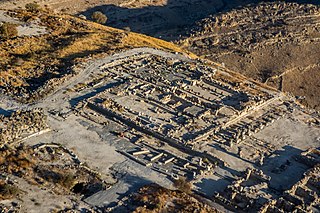
Hippos is an archaeological site in the Israel-Syria DMZ, on a hill in the northern Jordan Valley overlooking the Sea of Galilee. Between the 3rd century BCE and the 8th century CE, Hippos was the site of a Greco-Roman city, which declined towards the end of the Byzantine period and the Ealy Muslim period, and was abandoned after an earthquake in 749. Besides the fortified city itself, Hippos controlled two port facilities on the lake and an area of the surrounding countryside. Hippos was part of the Decapolis, or Ten Cities, a region in Roman Jordan, Syria and Israel that were culturally tied more closely to Greece and Rome than to the Semitic ethnoi around.

Tayma or Tema Teman/Tyeman/Yeman is a large oasis with a long history of settlement, located in northwestern Saudi Arabia at the point where the trade route between Yathrib (Medina) and Dumah (al-Jawf) begins to cross the Nefud desert. Tayma is located 264 km (164 mi) southeast of the city of Tabouk, and about 400 km (250 mi) north of Medina. It is located in the western part of Nefud desert.

Hisham's Palace is an important early Islamic archaeological site of the Umayyad dynasty from the first half of the 8th century, one of the so-called desert castles. It is located five km north of the town of Jericho, at Khirbat al-Mafjar in the West Bank. Spreading over 60 hectares, it consists of three main parts: a palace, an ornate bath complex, and an agricultural estate. Also associated with the site is a large park or agricultural enclosure (ḥayr) which extends east of the palace. An elaborate irrigation system provided the complex with water from nearby springs.

The newer Siloam Tunnel, also known as Hezekiah's Tunnel (Hebrew: תעלת חזקיהו, is a water channel that was carved within the City of David in ancient times, now located in the Arab neighborhood of Silwan in eastern Jerusalem. Its popular name is due to the most common hypothesis that it dates from the reign of Hezekiah of Judah and corresponds to the "conduit" mentioned in 2 Kings 20:20 in the Hebrew Bible. According to the Bible, King Hezekiah prepared Jerusalem for an impending siege by the Assyrians, by "blocking the source of the waters of the upper Gihon, and leading them straight down on the west to the City of David". By diverting the waters of the Gihon, he prevented the enemy forces under Sennacherib from having access to water.

Dumat al-Jandal, also known as Al-Jawf or Al-Jouf, is an ancient city of ruins and the historical capital of the Al Jawf Province, northwestern Saudi Arabia. It is located 37 km away from Sakakah. The name Dumat al-Jandal means literally "Dumah of the Stone"; the name Al-Jawf means "depression", referring to Wadi Sirhan. The city's ancient Akkadian name was Adummatu. Dumat al-Jandal has a boundary wall which is considered a historical site. Moreover, there is an oasis that has a number of ruins.
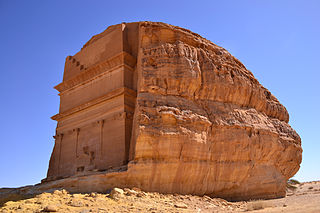
Hegra, known to Muslims as Al-Hijr, also known as Mada’in Salih, is an archaeological site located in the area of Al-'Ula within Al Madinah Region in the Hejaz, Saudi Arabia. A majority of the remains date from the Nabatean kingdom. The site constitutes the kingdom's southernmost and largest settlement after Petra, its capital. Traces of Lihyanite and Roman occupation before and after the Nabatean rule, respectively, can also be found.

Mount Tabor is located in Lower Galilee, Israel, at the eastern end of the Jezreel Valley, 18 kilometres (11 mi) west of the Sea of Galilee.
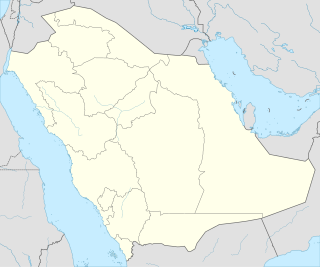
Tārūt Island is an island in the Persian Gulf belonging to the Eastern Province of Saudi Arabia, connected by two causeways to Qatif. It is six kilometers from the coast, and is the longest island in the Persian Gulf after Qeshm Island, extending from Ra’s Tannurah in the north to Qatif in the west. The island has an area of 70 square kilometers, and a population (2010) of 77,757. It contains a number of towns and villages, including Tārūt itself, Deyrah, and Darīn.
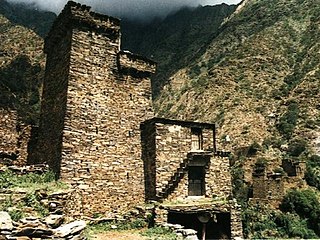
Saudi Arabia is the second biggest tourist destination in the Middle East with over 16 million visiting in 2017. Although most tourism in Saudi Arabia still largely involves religious pilgrimages, there is growth in the leisure tourism sector. As the tourism sector has been largely boosted lately, the sector is expected to be the white oil for Saudi Arabia. This is proved as tourism sector is expected to generate $25 billion in 2019. Potential tourist areas include the Hijaz and Sarawat Mountains, Red Sea diving and a number of ancient ruins.
Marid Castle is a historic military fortress located in the city of Dumat Al-Jandal in the Al-Jawf region, about 50 km away from Sakaka. It dates back to the first century AD, and the oldest mention of it dates back to the third century AD when the Queen Zenobia invaded Dumat al-Jandal and Tayma, and she could not storm the fortress. Therefore, she said: “ Marid has rebelled, and Ablaq has glorified.”

Sakākā is a city in northwestern Saudi Arabia which is the capital of Al Jawf Province. It is located just to the north of the An Nafud desert. Sakakah had a population of 242,813 at the 2010 census.

Place names in Palestine have been the subject of much scholarship and contention, particularly in the context of the Arab–Israeli conflict. The significance of place names in Palestine lies in their potential to legitimize the historical claims asserted by the involved parties, all of whom claim priority in chronology, and who use archaeology, map-making, and place names as their proofs. Many of the names underwent a process of Hebraization in the 1920s and 1950s.

Thirteen ancient towns have been discovered in Saudi Arabia up to the present day. These include Qaryat al-Fāw, the Al-Ukhdūd archeological area, Hegra, Jubbah, Tārūt, Al-Shuwayḥaṭiyah, Thāj, Taimaa and Dūmat Al-Jandal. There are still more ancient towns in Saudi Arabia, but little information is currently available on them. Saudi Arabia occupies a unique and distinctive geographic location, bridging civilizations between continents. In ancient times the Arabian peninsula served as a corridor for trade; therefore it saw the beginning of many civilizations, the relics of which are still evident today. The Saudi government has recently established the Saudi Commission for Tourism and Antiquities, which is responsible for the preservation of these cities.

Jubbah or Jubbat Ha'il is a city in Ha'il Region, Saudi Arabia, 90 kilometres (56 mi) north-west of the city of Ha'il. The city lies on the old caravan road between Najd and the eastern Mediterranean Sea. Although completely surrounded by the vast Nefud Desert, Jubbah is known for its abundant agriculture and plentiful water and has a population of 20,000.
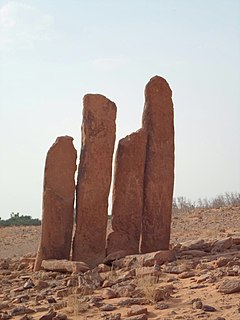
The Rajajel Columns is an archaeological site of pillars carved from sandstone thought to be 6,000 years old. It is located in the Al Jawf Region in Saudi Arabia. Specifically situated in the suburb of Qara south of Sakakah, it consists of 50 groups of erected stone columns called Rajajil. Some of the existing columns are higher than three meters, while they are about 60 cm thick.
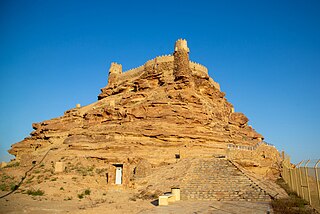
Zabal Castle is a castle in the north of the city of Sakaka in the Al-Jouf region in the north of Saudi Arabia.
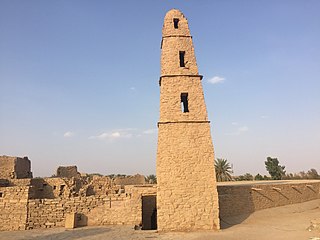
The Mosque of Omar Ibn al-Khattab is a historic mosque in Dumat al-Jandal in northern Saudi Arabia, located adjacent to the Marid Castle. It is one of the oldest mosques in the north of the Arabian Peninsula and is considered one of the important monuments in Al-Jawf and in Saudi Arabia in general.
1-^Al-Jawf, Hussain Ali Al-Khalifa, Nawwaf Dhabban Al-Rashed, Al-Jouf Wing, Janadriya 18, p. 7.
2-^ Al-Riyadh newspaper, Sisra Well named after the Leader of Canaani. Archived February 17, 2015, on the Wayback Machine.
3- ^ Archaeological Sites in Al-Jouf Region, Mr. Thamer Awad Al-Malki
4-^ Al-Jouf Land of Archeology and Civilization, Turki bin Ibrahim Al-Qahidan, 1st floor, Al-Rushd Library, Riyadh, 1425 AH / 2004AD, p. 31.